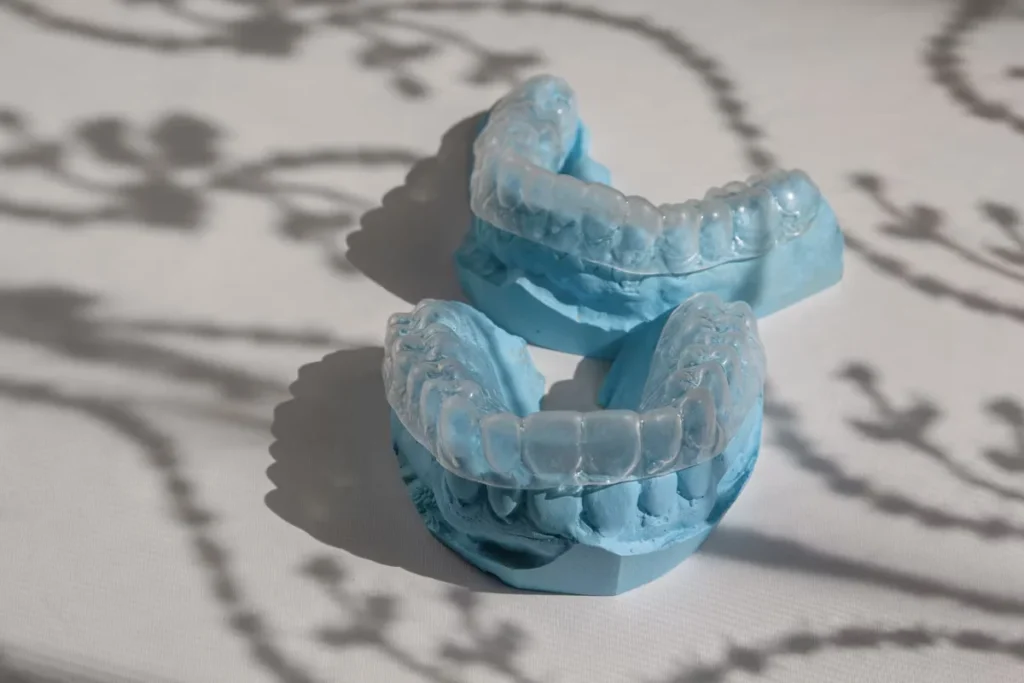Choosing between Invisalign vs braces is a big decision for anyone looking to improve their smile. Both are effective, but they offer very different journeys, some more comfortable, some more visible, and some quicker than others.
Let’s explore how they compare in terms of treatment time, daily care, and long-term results so you can confidently choose what’s right for your teeth and lifestyle.
What Are Traditional Braces?
Traditional braces involve metal brackets and wires that are fixed to your teeth and adjusted regularly by your orthodontist. These metal braces apply constant pressure to gradually move teeth into the correct position. While they’re visible, they remain a reliable choice for complex orthodontic issues, like severe misalignment or bite problems.
There are variations too; ceramic braces and lingual braces offer more discreet appearances, with tooth-colored ceramic braces blending with your smile and lingual options hiding behind the teeth.
What Is Invisalign Treatment?
Invisalign treatment uses a series of custom-made, clear plastic trays called Invisalign aligners that fit snugly over your teeth. These virtually invisible aligners are swapped out every 1-2 weeks to gently move your teeth. You take them out when you eat, brush, and floss, making them a popular choice for adults and teens looking for flexibility and fewer dietary restrictions.
Invisalign uses advanced technology to map out your full treatment plan, and every new aligner continues the gentle shift toward your goal.
How They Compare: Time, Maintenance, and Lifestyle Impact
Now that we’ve laid out what each option involves, let’s dig into how Invisalign and braces compare in real life. From how long they take to work, to how they fit into your daily routine, the differences become clearer once you look at the full picture.
Treatment Duration and Time Commitment
One of the first questions patients ask is, “Is Invisalign faster than braces?” The answer depends on your case.
For minor misalignment, Invisalign patients often finish treatment in 12 to 18 months. Braces, on the other hand, may be worn for 18 to 24 months, or longer for severe misalignment. However, Invisalign work relies heavily on patient discipline. If you’re not wearing the Invisalign trays for 20 to 22 hours a day, your progress can slow down.
Braces or Invisalign both require monitoring by your orthodontist, but Invisalign may mean fewer orthodontist visits.
Maintenance and Oral Hygiene
Cleaning around metal wires and brackets can be a challenge. Food particles can get stuck easily, leading to bad breath or plaque if not cleaned properly. Maintaining good oral hygiene with traditional braces takes extra effort and time.
Invisalign makes it easier. Just remove the trays, brush and floss as usual, and rinse the aligners. No navigating around metal brackets, which makes Invisalign or braces a personal decision based on how much time you’re willing to spend on daily care.
Lifestyle and Diet
Braces vs Invisalign also differ in how they affect your daily routine. With braces, you’ll need to avoid chewy foods, crunchy snacks, and anything sticky. These can bend wires or pop off brackets.
With Invisalign, there are no food limits; just take your trays out before eating. That means no change to your diet and no awkward moments trying to eat in public.
Still, unlike braces, Invisalign requires remembering to put the trays back in immediately after meals, and always carrying a case to keep them safe.

Cost, Results, and Aesthetics
As much as comfort and time matter, cost and appearance also play a big role in the decision between Invisalign and braces. Let’s explore how each option stacks up when it comes to price, visual appeal, and long-term effectiveness.
Invisalign vs Braces Cost Breakdown
Let’s talk numbers. Invisalign vs braces cost depends on your treatment needs and location. Metal braces are often more affordable, while Invisalign aligners cost slightly more due to the custom trays and technology involved.
That said, many dental insurance plans now cover both, so it’s worth checking during your initial consultation.
Aesthetic Preferences
Some patients are concerned with appearance. Clear aligners like Invisalign appeal to adults because they offer an invisible appearance. On the other hand, traditional metal brackets are more noticeable, though newer designs like ceramic dental braces can blend in more naturally.
If your work or social life involves public interaction, the subtlety of Invisalign may feel more comfortable.
Results and Long-Term Effectiveness
So, is Invisalign better than braces? The truth is that both options work.
Braces Invisalign comparisons often show equal results in simple to moderate cases. However, for complex orthodontic issues or severe bite problems, traditional metal braces might offer more precise tooth movements.
Both rely on controlled pressure to gradually straighten teeth, and both need retainers afterward to maintain your confident smile.
Want straighter teeth without the stress? Whether you’re dealing with misaligned teeth, bite issues, or just want to feel more confident, our team at Pure White Medical Center is here to help. Book a consultation today to explore whether braces or Invisalign is right for your smile. Call us at +971 4 288 3131, email info@purewhiteclinic.com, or book your consultation online

















